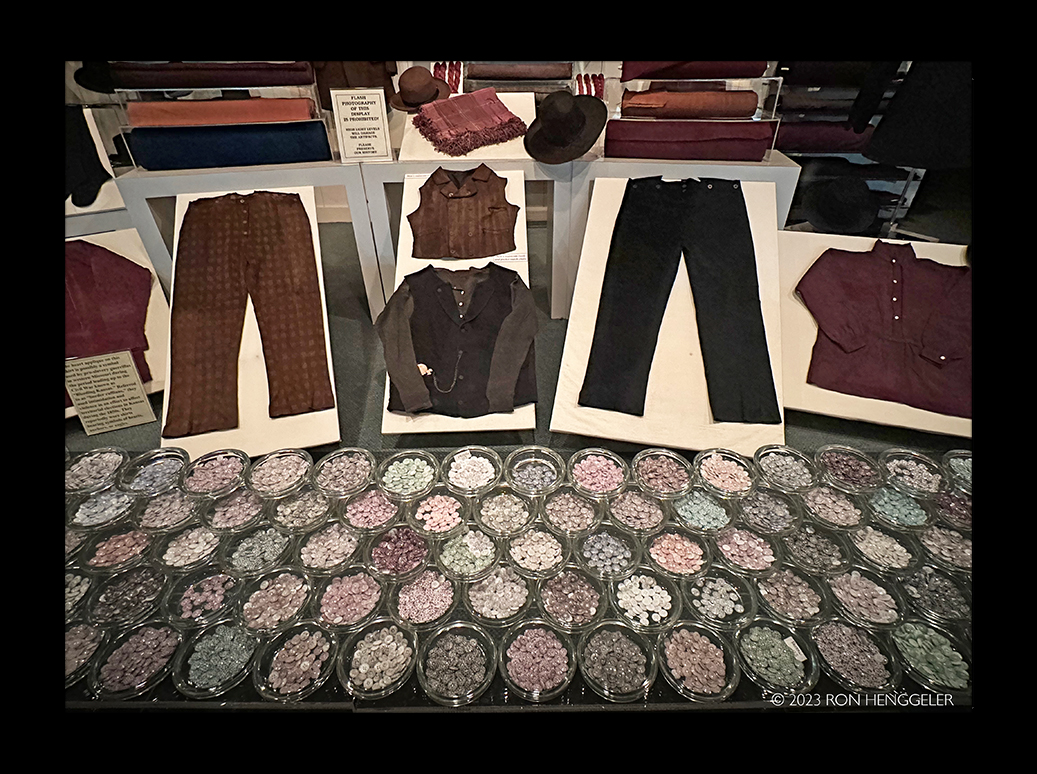RON HENGGELER |
March 31, 2023 |
||
A Historic Kansas City Attraction
|
||
Last week, I flew to Kansas City to be with Mom and my brothers and their families. We had come together to celebrate Mom's 90th birthday. While I was in Kansas City, I visited The Arabia Steamboat Museum, which I had wanted to see for many years. Here are some of the photos from my visit to the museum. |
||
|
||
On September 5, 1856, the Steamboat Arabia hit a log snag at Quindaro Bend, 10 miles north of Kansas City, and sank into 15 feet of water.
|
||
|
||
In 1988, 132 years after her sinking. five steamboat enthusiasts from the Kansas City area successfully recovered the Arabia and her historic cargo. With only personal financing for the project, this group of modern-day explorers succeeded where generations before them had failed. |
||
|
||
The Arabia Steamboat Museum is a unique Kansas City attraction: a time capsule of life on the American frontier in the mid-19th century. Visitors have a one-of-a-kind opportunity to experience everyday objects that made life possible for pioneers in the 1800s.Voted “Favorite Kansas City Hidden Gem” by Visit KC, the museum is one of Kansas City’s most popular attractions. It is the largest single collection of pre-Civil War artifacts in the world, featured by National Geographic Traveler, Smithsonian Magazine, PBS, Antiques Roadshow, Good Morning America, Southern Living, CNN, the History Channel and many other news and entertainment organizations.This text respectfully taken from: The Arabia Steamboat Museum |
||
|
||
The stern and rudder of the Arabia |
||
|
||
 |
||
Virtual Tour of The Arabia Steamboat Museum |
||
|
||
The Arabia was a side-wheeler built in Brownsville, Pennsylvania in 1853. She was 171 feet long and 54 feet wide, with a cargo hold depth of 4' 10". Sinking with a large quantity of whiskey and other frontier bound necessities, numerous attempts were made to obtain her treasure Although early attempts failed, in 1988 River Salvage, Inc. did succeed in recovering the precious cargo. Unearthing two hundred tons of treasure, the largest collection of its kind, theArabia and its cargo of west-bound merchandise is a moment frozen in time. |
||
|
||
|
||
Arabia's anchor and capstan |
||
|
||
Arabia Casualty |
||
|
||
Conflicting stories |
||
|
||
|
||
River Salvage, Inc. successfully excavates the Arabia and her cargo. They recover a "time capsule" of frontier life, including an international cargo of china, crystal, clothing, tools, hardware, and bottled fruits, vegetables and spirits. |
||
|
||
|
||
In 1897, Gale "Dad" Henson of Holt, Missouri, organized a company to recover 400 barrels of whiskey thought to be aboard the steamboat Arabia.
|
||
 |
||
|
||
|
||
The Steamboat Arabia was one of many casualties of the perilous Missouri River---the longest river in the United States that claimed nearly 400 other steamboats over its 2,500-mile course. In September 1856, the Arabia was carrying over 200 tons of cargo intended for general stores and homes in 16 midwestern frontier towns. The steamer was still fully loaded when it hit a tree snag and sank just 6 miles west of Kansas City. Due to erosion, the Missouri River changed course over time, and the Arabia was buried underground for over a century – along with all of its precious cargo. Lying 45 feet deep beneath a Kansas cornfield, the Arabia’s payload was protected from light and oxygen and, thus, was remarkably well preserved.Text respectfully taken from: The Arabia Steamboat Museum |
||
|
||
|
||
|
||
|
||
|
||
|
||
|
||
 |
||
|
||
|
||
The porcelain doll with outstretched arms is a Frozen Charlotte doll, found in a carpenter’s toolbox on the Steamboat Arabia. Frozen Charlotte dolls were were popular in the 19th century as children’s toys and also as moralizing tools. The tale of “Fair Charlotte” was first recorded by humorist Seba Smith in an 1844 periodical. A poem later evolved into a folk song and series of dolls, all with the intent of reminding children to listen to their mothers. You may notice that the doll is nude and is a baby doll, even though the protagonist of the poem is a teenager in a lovely dress. This is typical for 19th-century dolls; girls were encouraged to make clothes for them to practice their sewing skills.Respectfully taken from: Frozen Charlotte Doll |
||
|
||
|
||
|
||
|
||
In 1991, the Arabia’s cargo was transformed into the Arabia Steamboat Museum, a top Kansas City attraction and favorite local destination in the historic City Market. From fine china and carpentry tools to children’s toys and the world’s oldest pickles—the Arabia’s artifacts captivate visitors of all ages. The museum accommodates all types of visitors, including walk-ins, families, RV groups and more. It has become a favorite destination for Kansas City field trips year after year. |
||
|
||
|
||
|
||
 |
||
|
||
|
||
|
||
|
||
|
||
The Steamboat Arabia carried thousands of high-quality, hand-crafted trades items fashioned in the 1850s out of wood, metal and leather.This flow of finished products and raw materials formed a lifeline that fueled the settlements of the American frontier. |
||
|
||
|
||
|
||
|
||
 |
||
|
||
|
||
|
||
|
||
|
||
|
||
|
||
|
||
|
||
|
||
|
||
|
||
|
||
|
||
|
||
|
||
|
||
Personal tool boxThe carpenter who bought or made these tools suffered a great personal loss when the Arabia sank. He was left on the frontierwithout the tools to practice his craft. |
||
 |
||
|
||
|
||
|
||
|
||
|
||
|
||
|
||
|
||
|
||
Five of these bottles were untouched by the fury of the sinking. Others weren't quite as fortunate.The glass makers of the 19th century took pride in creating bottles that would be more than just a container. Using color and design the glass houses of the 19th century crafted a colorful legacy. |
||
|
||
|
||
The collection is a work in progress as preservationists continue to clean 60 more tons of artifacts in a preservation lab that’s available for visitors to watch. More artifacts and interactive displays are added on an ongoing basis. |
||
 |
||
|
||
|
||
|
||
|
||
|
||
|
||
|
||
|
||
|
||
 |
||
|
||
|
||
RARE TREASURE |
||
|
||
|
||
|
||
|
||
|
||
|
||
|
||
 |
||
|
||
|
||
|
||
The snag that sank the Great White Arabia |
||
|
||
In the winter of 1988, five men and their families banded together to begin the adventure of a lifetime … recovering the Steamboat Arabia's long-lost treasure.In 1991, the Arabia’s cargo was transformed into the Arabia Steamboat Museum, a top Kansas City attraction and favorite local destination in the historic City Market. From fine china and carpentry tools to children’s toys and the world’s oldest pickles—the Arabia’s artifacts captivate visitors of all ages. The museum accommodates all types of visitors, including walk-ins, families, RV groups and more. It has become a favorite destination for Kansas City field trips year after year.Text respectfully taken from: The Arabia Steamboat Museum |
||
|
||
The Arabia is depicted on the afternoon of her last voyage just seconds before striking a tree snag. It is possible that the crew member on the bow of the Arabia has just sighted a snag, and the man to the right of him has turned to warn the pilot. However, the alert came too late. A submerged walnut tree pierced her hull, sinking the Arabia on September 5, 1856, one-half mile below Parkville. Missouri. |
||
|
||
|
||
Newsletters Index: 2023, 2022, 2021 2020, 2019, 2018, 2017, 2016, 2015, 2014, 2013, 2012, 2011, 2010, 2009, 2008, 2007, 2006
Photography Index | Graphics Index | History Index
Home | Gallery | About Me | Links | Contact
© 2023 All rights reserved
The images oon this site are not in the public domain. They are the sole property of the
artist and may not be reproduced on the Internet, sold, altered, enhanced,
modified by artificial, digital or computer imaging or in any other form
without the express written permission of the artist. Non-watermarked copies of photographs on this site can be purchased by contacting Ron.


























































































